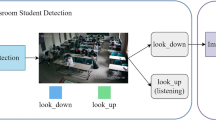Abstract
Though greatly significant for education evaluation and improvement the analysis of learning behaviour of students is, recognition of behaviour of students in the classroom surveillance based on one single image remains a challenging work due to problems including heavy occlusion, low resolution, small target size, large variability of camera viewpoints and significant perspective effect. In this paper, an innovative multiple-model method for recognizing students’ learning behaviour and counting the number of students in classroom scenes via detecting individuals’ head, which divides students’ learning behaviour into three categories according to the head posture, is proposed. Through viewing heads at different postures as targets of different categories, behaviour recognition problem is transformed into multi-target detection problem. As the density of students in different images varies dramatically, a multiple model consisting of three detection networks with different sized receptive fields and one switch net is applied that each detection network selects a large number of sub-windows with small stride size from input images to optimize the performance of the model in classroom scenes while the switch net is trained to predict the density of students in the input image and relays the classroom image to the corresponding detection network according to the students’ density prediction. This method is obtained to outperform other methods in terms of accuracy and speed in comparison with state-of-the-art methods on a real classroom surveillance dataset.









Similar content being viewed by others
References
Ko KE, Sim KB (2018) . Eng Appl Artif Intell 67:226. https://doi.org/10.1016/j.engappai.2017.10.001. http://www.sciencedirect.com/science/article/pii/S0952197617302579
Zheng Y, Yao H, Sun X, Zhao S, Porikli F (2017) Signal processing
Sefidgar YS, Vahdat A, Se S, Mori G (2015) . Comput Vis Image Underst 135(4):16
Dalal N, Triggs B (2005) In: 2005. CVPR 2005. IEEE computer society conference on computer vision and pattern recognition, pp 886–893
Alonso IP, Llorca DF, Sotelo M, Bergasa LM, De Toro PR, Nuevo J, Ocaña M (2007) . IEEE Trans Intell Transp Syst 8(2):292
Viola P, Jones MJ, Snow D (2005) . Int J Comput Vis 63(2):153
Hotta K (2002) In: IEEE workshop on applications of computer vision, p 105
Ye Q, Dong J, Zhang Y (2015) . Optik - International Journal for Light and Electron Optics 126 (23):4712
Patrona F, Chatzitofis A, Zarpalas D, Daras P (2018) ., vol 76. https://doi.org/10.1016/j.patcog.2017.12.007. http://www.sciencedirect.com/science/article/pii/S0031320317304910
Meshry M, Hussein ME, Torki M (2016) In: Applications of computer vision, pp 1–9
Amor BB, Su J, Srivastava A (2015) . IEEE Trans Pattern Anal Mach Intell 38(1):1
Tang GJ, Peng T (2012) In: International congress on image and signal processing, pp 267–270
Dollar P, Wojek C, Schiele B, Perona P (2009) Proc Cvpr, pp 304–311
Huang J, Su K, El-Den J, Hu T, Li J (2014) . Math Probl Eng, 2014,(2014-8-31) 2014(1):1
Pham MT, Chain TJ (2007) In: IEEE international conference on computer vision, pp 1–7
Geismann P, Schneider G (2008) In: Intelligent vehicles symposium, pp 554–559
Schuldt C, Laptev I, Caputo B (2004) In: International conference on pattern recognition, Vol 3, pp 32–36
Felzenszwalb PF, Girshick RB, Mcallester D (2013) . Commun ACM 56(9):97
Girshick R, Donahue J, Darrell T, Malik J (2014) In: 2014 IEEE conference on computer vision and pattern recognition (CVPR), vol 00, pp 580–587. https://doi.org/10.1109/CVPR.2014.81
Uijlings JR, Sande KE, Gevers T, Smeulders AW (2013) . Int J Comput Vis 104(2):154
He K, Zhang X, Ren S, Sun J (2014) . IEEE Trans Pattern Anal Mach Intell 37(9):1904
Girshick R (2015) Computer science
Ren S, He K, Girshick R, Sun J (2015) In: International conference on neural information processing systems, pp. 91–99
Dai J, Li Y, He K, Sun J (2016)
Redmon J, Divvala S, Girshick R, Farhadi A (2015) pp 779–788
Liu W, Anguelov D, Erhan D, Szegedy C, Reed S, Fu CY, Berg AC (2015) pp 21–37
Sam DB, Surya S, Babu RV (2017) In: IEEE conference on computer vision and pattern recognition, pp 4031–4039
He K, Zhang X, Ren S, Sun J (2016) In: Computer vision and pattern recognition, pp 770–778
Su K, Chen W, Lei N, Zhang J, Qian K, Gu X (2017) . Comput Aided Des 82:42. https://doi.org/10.1016/j.cad.2016.05.020. http://www.sciencedirect.com/science/article/pii/S0010448516300495. Isogeometric Design and Analysis
Su K, Cui L, Qian K, Lei N, Zhang J, Zhang M, Gu XD (2016) . Comput Aided Geom Des 46:76. https://doi.org/10.1016/j.cagd.2016.05.005. http://www.sciencedirect.com/science/article/pii/S0167839616300528
Su K, Chen W, Lei N, Cui L, Jiang J, Gu XD (2016) . Comput Aided Des 78:188. https://doi.org/10.1016/j.cad.2016.04.007. http://www.sciencedirect.com/science/article/pii/S0010448516300197. SPM 2016
Acknowledgements
We thank the editor and all the anonymous reviewers for their valuable advice and suggestions to improve the current work.
Funding
This work is financially supported by the National Key Research and Development Program of China (No. 2016YFB052204), the National Natural Science Foundation of China (No.61772379) and the Independent Scientific Research Project of Wuhan University (No. 2042018kf0246).
Author information
Authors and Affiliations
Corresponding author
Additional information
Publisher’s note
Springer Nature remains neutral with regard to jurisdictional claims in published maps and institutional affiliations.
Rights and permissions
About this article
Cite this article
Su, K., Li, X., Zhou, C. et al. Learning behaviour recognition based on multi-object image in single viewpoint. Pers Ubiquit Comput 25, 1081–1090 (2021). https://doi.org/10.1007/s00779-019-01286-1
Received:
Accepted:
Published:
Issue Date:
DOI: https://doi.org/10.1007/s00779-019-01286-1




